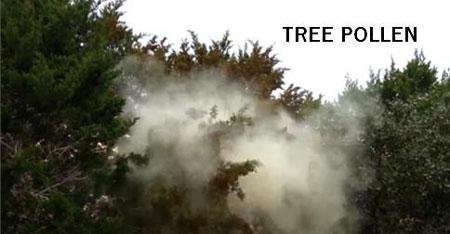The pollen is small grain transferred from one plant to the other to fertilize the female flower to reproduce plant species. Some flowery plants produce a very small amount of pollen which is distributed by birds and bees from one plant to the other.
Grass, weeds, and trees produce vast quantities of pollen. They rely on winds to distribute it. They can move long distances and cause an allergic reaction in people.
Since pollen is seasonal allergies caused by it are called pollen allergies or seasonal allergies. The main symptoms are itchy and watery eyes, sneezing, congestion, runny nose, and wheezing.
It is impossible to completely avoid pollen allergy because of two reasons. One is that trees, weeds, and grass produce very large quantities of pollen, and two is that pollen gets distributed in large coverage areas ranging miles. Your strategy has to be to reduce the exposure as much as possible.
If you or one or more of your family members are prone to pollen allergy, then while buying a house, ensure that some of the trees that cause pollen allergy are neither present in the backyards of the house you are buying nor in the neighbors’ backyards.
There are three main sources of pollen allergies.
1. Tree Pollen Allergy
There are more than 100 types of trees that cause pollen allergies. Most common among them are Oak, Pine, Walnut, Sycamore, Olive, Hickory, maple, palm and willow, Fig, Pear, Plum, Fir, Palm, Redwood, and Elm.
If you are prone to tree pollen allergy, then you must take precautions to remain far away from exposure to these trees during the season.
As early as January, the symptoms of tree pollen allergy will begin to appear and they last up to the end of spring. This is the time when the trees begin to produce flowers and new leaves.
Symptoms of tree pollen allergies are very similar to other allergy symptoms including a runny, stuffy, and/or congested nose, sneezing, watery eyes, and itchy throat and eyes.
2. Ragweed Pollen Allergy
Ragweed is a weed that can grow almost anywhere. August to November is a time for the ragweed to bloom and release pollen. Ragweed pollen levels are highest in mid-September.
Anyone who is allergic to dust, mites, and other pollen can get a ragweed pollen allergy. It is more of a genetic condition also. So, if your blood relatives have allergic reactions due to exposure to ragweed pollen,
3. Grass Pollen Allergy
The grass is one of the main triggers of pollen allergy. Grass pollen allergy is not only difficult to prevent but is also one of the most difficult to deal with it because it is seasonal and regional. Pollen levels get affected by the time of the day, temperatures, and rain.
Not all types of grasses cause pollen allergy. Out of more than a thousand species of grass, only a small percentage cause allergies. The most common grasses among them causing grass pollen allergy include Orchard grass, Johnson grass, Kentucky bluegrass, Timothy grass, Bermuda grass, and Sweet vernal grass.
The impact of all these seasonal allergies can be reduced if you keep track of the pollen count in your area during the season.
Pollen Count
The pollen count is nothing but a count of pollen grains in a certain amount of air in a specific period, usually 24 hours.
Rain, humidity, wind, and sun can keep changing these pollen concentrations in the air. Usually, the highest pollen concentrations are present during 11:00 am – 3:00 pm.
Different concentrations of the tree, grass or ragweed pollen can cause allergies depending on your immunity. Therefore, if you know which kind of pollen gives you an allergic reaction then you must focus on that pollen count rather than worrying about the other pollen counts.
You may be someone who gets allergies from all types of pollen then you have to look at all the pollen counts. Check pollen count in the weather reports.
Higher pollen counts usually mean the risks of getting allergic reactions, are increased.
Precautions
You simply can't prevent Grass Pollen Allergy if you are prone to allergies. Bad news! At best you can reduce the exposure. You have to learn to live with it.
You can reduce incidences by taking the following precautions:
- Wear a mask during lawn mowing or ask someone else who is not prone to allergies to do the job.
- Make sure the grass cut is short and choose ground covers such as Irish moss etc., which don't produce much pollen.
- Reduce outdoor activities during high pollen levels times such as between 05:00 - 10:00 am. Pollen levels also drop after heavy rains.
- Keep windows closed and use air conditioners because windows and attic fans can attract pollen so
- Dry your clothes in the automatic electric dryer rather than hanging the clothes outdoors.
We are all prone to allergies, so it is difficult to completely prevent them. If you know the triggers or allergens, then you can reduce the possibilities by avoiding exposure to those triggers. If you can't avoid it, then the best course of action is to treat it and stay in better shape.

